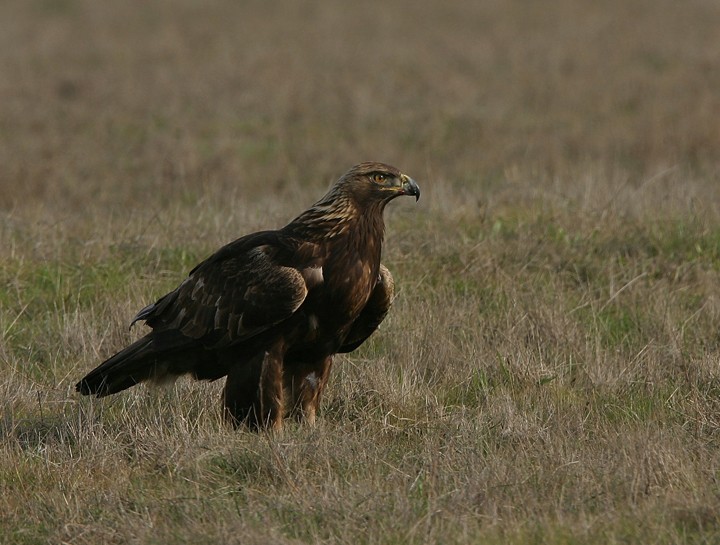Golden Eagle
A species of Greater True Eagles, Also known as Jackrabbit Eagle, Mountain Eagle, Calumet Bird, Ringtail Scientific name : Aquila chrysaetos Genus : Greater True Eagles
Golden Eagle, A species of Greater True Eagles
Also known as:
Jackrabbit Eagle, Mountain Eagle, Calumet Bird, Ringtail
Botanical name: Aquila chrysaetos
Genus: Greater True Eagles
 Photo By Gregory "Slobirdr" Smith , used under CC-BY-SA-2.0 /Cropped and compressed from original
Photo By Gregory "Slobirdr" Smith , used under CC-BY-SA-2.0 /Cropped and compressed from original Description
A large raptor, the golden Eagle is impressive while perching or in flight. The goldish-colored feathers around the nape give the raptor its occasional common name of 'Golden Eagle' but they are often difficult to see when it is in the air. The raptor is primarily seen in open areas where it searches for small mammals.
Size
69 - 97 cm
Life Expectancy
25 years
Nest Placement
Cliff
Clutch Size
1 - 3 eggs
Incubation Period
1 brood
Number of Broods
41 - 45 days
Nestling Period
45 - 81 days
Feeding Habits
Golden Eagle predominantly consume small to medium-sized mammals like hares, rabbits, and squirrels. They also hunt larger prey such as deer and may feed on carrion. These birds actively hunt during daylight, with a 20% success rate observed in Idaho.
Habitat
Golden Eagle thrive in open and semi-open landscapes, often in regions marked by native vegetation and minimal human development. This bird species typically inhabits environments such as mountainous areas at altitudes up to 12,000 feet, canyonlands, and regions with steep bluffs alongside rivers. They steer clear of dense forests, urban expanses, and heavily farmed lands. Golden Eagle prefer nesting on cliffs and rugged escarpments, within biomes that include grasslands, chaparral, shrublands, and occasionally forested locales.
Nest Behavior
Golden Eagle pairs start constructing nests 1-3 months before egg laying, often reusing and enlarging existing nests for multiple seasons. These nests may be alternated with secondary nests.
Nest Characteristics
Golden Eagle nests are typically located on cliffs, trees, ground, or artificial structures with clear views of surroundings. Made from sticks, vegetation, and assorted objects like bones and wires. They line their nests with locally sourced vegetation, which may include aromatic leaves to deter insects. Nests are massive, averaging 5-6 feet in width and 2 feet in height, featuring a bowl of about 3 feet by 2 feet deep.
Dite type
Carnivorous
People often ask
Migration Overview
Most populations of golden eagles are sedentary, but the species is actually a partial migrant. In Finland, most banded juveniles move between 1,000 and 2,000 km (620 and 1,240 mi) due south, whereas adults stay locally through winter. Further east, conditions are too harsh for even wintering territorial adults. Golden eagles that breed from the Kola peninsula to Anadyr in the Russian Far East migrate south to winter on the Russian and Mongolian steppes, and the North China Plains. 
General Info
Feeding Habits
Bird food type
Behavior
Golden Eagle exhibit remarkable agility and speed, especially during their spectacular sky-dancing and pendulum flight displays, which involve a series of steep dives and swoops. Their typical daily activities encompass hunting, often displayed through impressive aerial tactics, reaching speeds up to 200 miles per hour during dives. Remarkably, golden Eagle also demonstrate adaptability by occasionally hunting on the ground, exhibiting a dynamic flapping-run. Mated pairs exhibit cooperative behavior when hunting, especially with larger prey like jackrabbits, showcasing complex interaction with their environment. These behaviors exemplify golden Eagle's distinctiveness within their natural habitat.
Distribution Area
There are six extant subspecies of golden eagle that differ slightly in size and plumage. This subspecies is found almost throughout Europe, including the British Isles (mainly in Scotland), a lion’s share of Scandinavia, southern and northernmost France, Italy and Austria. In Eastern Europe, it is found from Estonia to Romania, Greece, Serbia and Bulgaria in southeastern Europe. It is also distributed through European Russia, reportedly reaching its eastern limit around the Yenisei River in Russia, also ranging south at a similar longitude into western Kazakhstan and northern Iran. 
Species Status
Although widespread and quite secure in some areas, in many parts of the range golden eagles have experienced sharp population declines and have even been extirpated from some areas. The total number of individual golden eagles from around the range is estimated to range somewhere between 170,000 and 250,000 while the estimated total number of breeding pairs ranges from 60,000 to 100,000. On a global scale, the golden eagle is not considered threatened by the IUCN. 